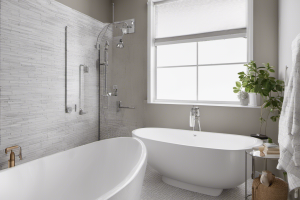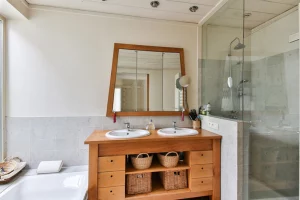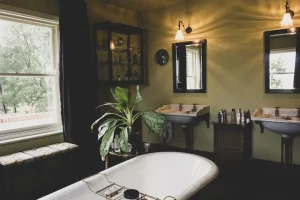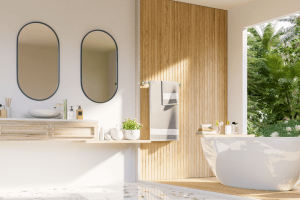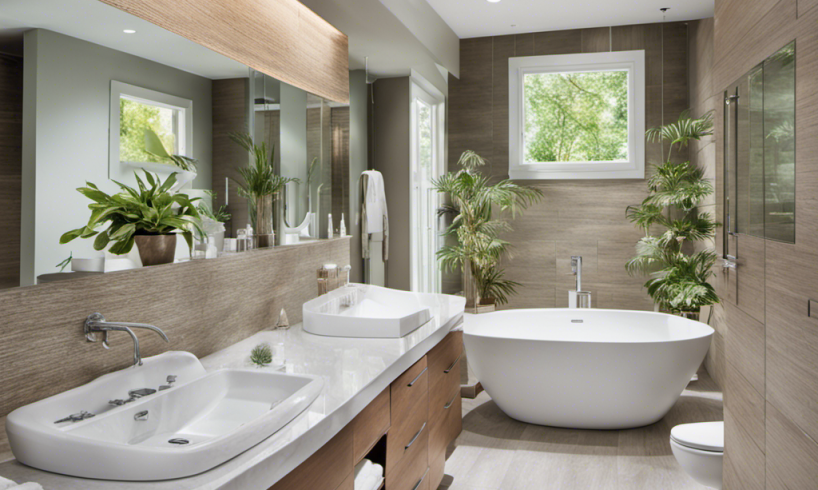
Embracing Innovation: The Next Generation of Bathroom Makeovers
Imagine stepping into a space that not only caters to your functional needs but also serves as a personal retreat, a sanctuary where you can soak away the stresses of the day. This is the future of bathroom renovations – a perfect blend of functionality, relaxation, and cutting-edge technology. As more and more homeowners recognize the bathroom's potential beyond its traditional role, they are investing in renovations that transform the space into a personalized oasis.
‘Revitalizing Your Sanctuary: The Future of Bathroom Renovations' delves into this emerging trend, exploring the innovative design concepts and technological advancements that are setting the pace in modern bathroom makeovers. From smart showers that remember your preferred water temperature to self-cleaning toilets, heated floors, and even mood-enhancing lighting systems, this article will guide you through the exciting possibilities that lie ahead. We'll also provide expert advice on how to plan your renovation to create a space that not only enhances your home's value but also contributes to your wellbeing.
1. The Importance of Personalized Spaces
The article emphasizes the growing trend of personalizing bathrooms to make them feel like sanctuaries. It suggests that future bathroom renovations will focus on creating a personalized and comfortable space that reflects the homeowner's style and needs.
2. The Rise of Smart Bathrooms
The future of bathroom renovations lies in technology. The article predicts that smart bathrooms, equipped with digital showers, automatic faucets, and intelligent toilets, will become increasingly popular. These features not only enhance convenience but also contribute to water and energy conservation.
3. Sustainability is Key
The article underscores the importance of sustainability in bathroom renovations. It predicts a future where eco-friendly materials, water-saving fixtures, and energy-efficient lighting will be the norm, contributing to a greener planet and lower utility bills for homeowners.
4. The Role of Wellness in Bathroom Design
The article highlights the growing trend of incorporating wellness features into bathroom designs. Elements like steam showers, aromatherapy, and mood lighting can transform bathrooms into wellness retreats, promoting relaxation and stress relief.
5. The Value of Professional Guidance
The article stresses the value of hiring a professional for bathroom renovations. Professionals bring expertise and can help homeowners navigate the myriad of choices, ensuring the end result is both functional and aesthetically pleasing.
The High Cost of Luxury
The first controversial aspect of ‘Revitalizing Your Sanctuary: The Future of Bathroom Renovations' is the high cost associated with luxury renovations. Advocates argue that these renovations add significant value to a home, both in terms of its market value and the quality of life for its inhabitants. They point to the increasing popularity of spa-like bathrooms, complete with high-end fixtures, heated floors, and even saunas, as evidence of this trend.
Critics, however, argue that the high cost of these renovations can put them out of reach for many homeowners. They also question whether such luxurious features are truly necessary or if they simply cater to an increasingly materialistic society. Some also argue that the focus on luxury renovations can detract from more pressing home improvement needs, such as improving energy efficiency or addressing structural issues.
The Environmental Impact
Another controversial aspect of ‘Revitalizing Your Sanctuary: The Future of Bathroom Renovations' is the environmental impact of these projects. Proponents argue that many modern bathroom features, such as low-flow toilets and showerheads, can help to reduce a home's water usage and thus its environmental footprint. They also point to the use of sustainable materials, such as reclaimed wood or recycled glass, as evidence of the industry's commitment to environmental responsibility.
Critics, however, contend that the renovation process itself can be environmentally damaging. They point to the waste generated during demolition and construction, as well as the energy used during the manufacturing and transportation of new materials. They argue that a truly environmentally-friendly approach would prioritize preserving and repairing existing features rather than replacing them.
The Question of Accessibility
The third controversial aspect of ‘Revitalizing Your Sanctuary: The Future of Bathroom Renovations' is the question of accessibility. Advocates argue that modern bathroom designs can greatly improve accessibility for individuals with mobility issues. They point to features such as walk-in showers, grab bars, and higher toilets as evidence of this trend.
Critics, however, argue that the focus on luxury and aesthetics can sometimes overshadow the need for accessibility. They contend that some popular design trends, such as freestanding bathtubs or vessel sinks, can actually make a bathroom less accessible for individuals with mobility issues. They also point to the high cost of many accessibility features, arguing that this can put them out of reach for many homeowners.
Embracing the Wellness Trend: The Shift Towards Spa-Inspired Bathrooms
As the wellness movement continues to gain momentum, it has begun to permeate the bathroom renovation industry. Homeowners are no longer satisfied with simple, functional bathrooms; they are seeking spaces that promote relaxation and rejuvenation. This has led to a surge in spa-inspired bathroom designs, with features such as rainfall showerheads, freestanding bathtubs, and heated floors becoming increasingly popular.
The impact on the industry has been profound. Contractors and designers are having to adapt to this new demand, learning about and sourcing new materials and technologies to meet their clients' needs. It has also prompted the development of new products and services, with companies launching ranges of spa-like fixtures and fittings, and even offering ‘bathroom wellness' consultations.
Smart Technology: The Bathroom of the Future
The rise of smart technology is another key trend shaping the future of bathroom renovations. From voice-activated showers to mirrors with built-in virtual assistants, the bathroom is becoming a hub of innovation. This is driven by a desire for convenience and efficiency, as well as the increasing integration of technology into all aspects of our lives.
This trend is having a significant impact on the industry, with companies having to keep up-to-date with the latest technological advancements and incorporate them into their designs. It has also opened up new opportunities for tech companies and startups, who are developing and launching innovative new products to meet this growing demand.
Sustainability: The Green Bathroom Revolution
Sustainability is another key factor influencing bathroom renovations. As environmental concerns become increasingly mainstream, homeowners are seeking ways to make their bathrooms more eco-friendly. This includes everything from installing low-flow fixtures to reduce water usage, to using sustainable materials such as bamboo for cabinetry.
This trend is forcing the industry to rethink its practices and products. Many companies are now offering ‘green' renovation services, and developing new, eco-friendly products. It has also led to increased regulation and standards around water usage and waste, which companies must comply with. This trend is not only changing the industry but also contributing to the wider fight against climate change.
The Evolution of Bathroom Design
Bathroom design has evolved significantly over the years, from purely functional spaces to personal sanctuaries. This section will explore the history of bathroom design, from the utilitarian designs of the early 20th century to the spa-inspired bathrooms of today. It will also look at how societal changes, technological advancements, and a greater emphasis on personal wellbeing have influenced bathroom design. Case studies from notable interior designers and architects will be included to provide real-world examples of how bathroom design has evolved.
Emerging Trends in Bathroom Renovations
This section will delve into the emerging trends in bathroom renovations, such as the use of sustainable materials, the incorporation of smart technology, and the shift towards more open, airy spaces. It will explore how these trends are not only changing the look and feel of bathrooms but also how they are used. Interviews with industry experts will provide insights into why these trends are gaining popularity and how they are likely to evolve in the future.
The Impact of Technology on Bathroom Design
Technology is playing an increasingly important role in bathroom design, from smart showers that conserve water to digital mirrors that can display the news. This section will look at the latest technological innovations for the bathroom, how they are enhancing the user experience, and what we can expect to see in the future. It will also discuss the challenges and opportunities that these technologies present for bathroom renovations.
Sustainability and Bathroom Renovations
As more people strive to live sustainably, this ethos is being reflected in bathroom renovations. This section will explore how sustainability is influencing bathroom design, from the use of recycled materials to energy-efficient fixtures. It will also look at how homeowners and designers are finding creative ways to make bathrooms more eco-friendly. Case studies of sustainable bathroom renovations will be included to provide inspiration and practical tips.
The Wellness Movement and Bathroom Design
The wellness movement is having a significant impact on bathroom design, with more people viewing their bathroom as a place to relax and rejuvenate. This section will explore how the wellness movement is influencing bathroom renovations, from the inclusion of spa-like features to the use of calming colors and natural materials. Interviews with wellness experts and interior designers will provide insights into how to create a bathroom that promotes wellbeing.
Planning for the Future: Ageing and Accessibility in Bathroom Design
As the population ages, there is a growing need for bathrooms that are accessible and safe for all ages. This section will explore how bathroom renovations can incorporate features that accommodate ageing and disability, such as walk-in showers and grab bars. It will also look at how good design can make these features blend seamlessly into the overall aesthetic of the bathroom. Case studies and expert advice will be included to provide practical guidance for those considering an accessible bathroom renovation.
Transforming a Time-Worn Space into a Modern Haven
One of the most compelling examples of a successful bathroom renovation is the transformation of a century-old bathroom by renowned interior designer, Sarah Richardson. This space, located in a historic home in Toronto, was originally filled with outdated fixtures and a worn-out aesthetic.
Richardson's team began by stripping the room down to its bones, revealing the original brickwork and wooden beams. This raw and rustic backdrop was then juxtaposed with sleek, modern fixtures such as a free-standing tub, a glass-enclosed shower, and a floating vanity. The blend of old and new elements resulted in a unique, chic, and inviting space.
The success of this renovation lies in the balance between preserving the original character of the home and the of modern comforts and aesthetics. This project illustrates the key point that successful bathroom renovations are not just about updating fixtures, but about creating a harmonious blend of the old and new.
Maximizing Space in a Compact Bathroom
Another noteworthy case study is the renovation of a small, cramped bathroom in a San Francisco apartment by interior design firm, Studio Revolution. The original bathroom was a mere 35 square feet and was in desperate need of a makeover to maximize the limited space.
The designers tackled the space issue by installing a wall-mounted sink and toilet, freeing up valuable floor space. A large mirror was also installed to create the illusion of a larger room. The shower was outfitted with a glass door, eliminating the visual barrier of a traditional shower curtain.
The designers also made use of vertical space by installing open shelves above the toilet for additional storage. The final result was a bathroom that not only looked bigger but was also more functional.
The success of this project underscores the point that even the smallest of bathrooms can be transformed into a functional and aesthetically pleasing space with clever design and space-saving fixtures.
A Luxurious Spa-Like Retreat
The third case study is a luxury bathroom renovation carried out by Los Angeles-based designer, Lori Dennis. The project involved the transformation of a large but outdated bathroom into a luxurious, spa-like retreat.
Key to this transformation was the installation of a large, freestanding soaking tub, a steam shower, and a double vanity with ample storage. The room was finished with a calming, neutral color palette, and high-end materials such as marble and teak were used throughout.
The success of this renovation lies in the designer's ability to create a sanctuary-like space within the home, where the homeowners can relax and unwind. This project underscores the point that a successful bathroom renovation is one that not only enhances the aesthetics of the space but also improves the quality of life of the homeowners.
Embracing the Smart Tech Revolution
As we navigate the digital age, the integration of smart technology in every aspect of our lives has become inevitable. The bathroom, often considered a sanctuary, is no exception. From voice-activated showers to self-cleaning toilets, the possibilities are endless.
Touchless Technology
Touchless technology has grown in popularity, particularly in the wake of the global pandemic. This technology allows users to control various bathroom fixtures such as faucets, soap dispensers, and toilets without any physical contact, reducing the spread of germs. Infrared sensors detect the presence of an object, triggering the water flow or soap release.
Smart Showers
Smart showers are a game-changer in the bathroom renovation industry. They allow users to pre-set their preferred water temperature, pressure, and even steam settings. Some smart showers can be voice-activated or controlled via a mobile device, offering an elevated experience for users.
Intelligent Toilets
The advent of intelligent toilets brings a new level of comfort and hygiene. These toilets come with features such as automatic lid opening and closing, self-cleaning capabilities, and even seat warming. Some models also offer health monitoring features, such as urine analysis and blood pressure monitoring.
Material Innovation and Sustainability
The future of bathroom renovations is not just about technology; it’s also about using innovative materials and promoting sustainability.
Recycled Materials
More homeowners are opting for recycled materials in their bathroom renovations. Recycled glass tiles, for instance, provide a unique aesthetic while reducing landfill waste. Similarly, reclaimed wood can add a rustic touch while promoting sustainability.
Water-Saving Fixtures
Water conservation is a growing concern worldwide. To address this, manufacturers are developing water-efficient fixtures such as low-flow showerheads and dual-flush toilets. These fixtures can significantly reduce water usage without compromising functionality.
Lighting and Color Schemes
Lighting and color schemes play a crucial role in creating the desired ambiance in a bathroom.
LED Lighting
LED lighting is gaining popularity due to its energy efficiency and longevity. LED lights can also be incorporated into mirrors and cabinets for a modern, sophisticated look.
Color Psychology
The use of color psychology in bathroom renovations can influence mood and perception. For instance, blue hues can evoke feelings of tranquility and calmness, while earth tones can create a warm, cozy ambiance.
Space Utilization and Layout
Optimizing space and layout is essential in creating a functional and aesthetically pleasing bathroom.
Walk-In Showers
Walk-in showers, with their sleek design and easy accessibility, are becoming a staple in modern bathrooms. They not only save space but also add a luxurious touch.
Built-In Storage
Built-in storage solutions such as recessed cabinets and shelves can maximize space while maintaining a clean, uncluttered look. They offer practical storage solutions without compromising on style.
The future of bathroom renovations lies in the perfect blend of technology, sustainability, aesthetics, and functionality. by embracing these trends, homeowners can create a bathroom that is not just a space for hygiene, but a personal sanctuary that caters to their unique needs and preferences.
The Birth of the Bathroom: A Historical Perspective
Bathroom renovations, as we understand them today, have their roots in the ancient civilizations of Rome and Greece. These societies were known for their advanced public bathhouses, which were not only places of hygiene but also social hubs. However, private bathrooms were a luxury, often limited to the wealthy.
As societies evolved, so did the concept of the bathroom. During the Middle Ages, the bathroom was largely a practical space, usually a simple room with a basin and a chamber pot. The Renaissance period saw the bathroom becoming slightly more elaborate, often adorned with artwork, but still primarily functional.
The Victorian Era: The Birth of the Modern Bathroom
The Victorian era marked a significant turning point in the history of bathroom design. Indoor plumbing became more common, leading to the development of the first recognizably modern bathrooms. These spaces were designed with hygiene and functionality in mind, often featuring a bathtub, a washstand, and a toilet.
20th Century: The Evolution of the Bathroom
The 20th century marked the democratization of the bathroom. As plumbing became more accessible, bathrooms became a standard feature in most homes. The bathroom evolved from a purely functional space to a private sanctuary, a place of relaxation and self-care. This period also saw the of bathroom décor and design, with homeowners starting to take an interest in the aesthetic appeal of their bathrooms.
Post-Modern Era: The Bathroom as a Personal Sanctuary
In the post-modern era, the bathroom has become a personal sanctuary, a place for relaxation, rejuvenation, and self-care. This shift has led to a surge in bathroom renovations, with homeowners seeking to create a space that reflects their personal style and meets their specific needs.
Bathroom renovations in the post-modern era often involve replacing outdated fixtures with modern, energy-efficient models, installing luxurious features like spa tubs and rain showers, and incorporating design elements that create a soothing, spa-like atmosphere.
Today, the trend in bathroom renovations is all about creating a personal sanctuary. Homeowners are increasingly seeking to transform their bathrooms into spa-like retreats, with features like heated floors, steam showers, and soaking tubs becoming more common.
Sustainability is also a key focus in modern bathroom renovations. Homeowners are increasingly opting for water-saving fixtures, energy-efficient lighting, and materials that are both durable and environmentally friendly.
In addition, smart technology is making its way into the bathroom, with features like digital showers, smart mirrors, and voice-activated lighting becoming more common. These features not only enhance the user experience but also contribute to the overall efficiency of the bathroom.
The future of bathroom renovations is likely to continue to be influenced by these trends, as homeowners seek to create spaces that are not only functional and stylish, but also sustainable and technologically advanced.
1. What does the term ‘Revitalizing Your Sanctuary' mean in the context of bathroom renovations?
‘Revitalizing Your Sanctuary' refers to the process of transforming your bathroom into a personal oasis. It involves updating and renovating your bathroom with the latest trends and technologies to make it more comfortable, functional, and aesthetically pleasing.
2. What are some of the latest trends in bathroom renovations?
Some of the latest trends in bathroom renovations include:
- Installation of smart showers and toilets
- Use of sustainable materials
- Incorporation of natural elements
- Use of bold, vibrant colors
- Installation of large, luxurious bathtubs
3. How can I make my bathroom more environmentally friendly?
There are several ways to make your bathroom more environmentally friendly:
- Install water-saving fixtures like low-flow toilets and showerheads.
- Use LED lighting instead of traditional bulbs.
- Choose sustainable materials like bamboo for cabinetry and flooring.
- Opt for natural cleaning products to reduce chemical use.
4. What are smart showers and how do they enhance the bathroom experience?
Smart showers are digitally controlled shower systems that allow you to customize your shower experience. They can be programmed to deliver water at your preferred temperature and pressure. Some even have features like steam control and mood lighting. These features enhance the bathroom experience by providing a more personalized and luxurious shower.
5. How can I incorporate natural elements into my bathroom?
You can incorporate natural elements into your bathroom by using materials like stone and wood for your countertops, floors, and walls. You can also add plants to your bathroom to create a more natural and serene atmosphere.
6. How much does a typical bathroom renovation cost?
The cost of a bathroom renovation can vary widely depending on the scope of the project. On average, a basic bathroom renovation can cost anywhere from $3,000 to $12,000. A more extensive renovation with high-end materials and fixtures can cost $15,000 or more.
7. How long does a typical bathroom renovation take?
A typical bathroom renovation can take anywhere from 2 to 3 weeks for a simple remodel. More extensive renovations can take several weeks or even months to complete.
8. What are some common mistakes to avoid during a bathroom renovation?
Some common mistakes to avoid during a bathroom renovation include:
- Not setting a realistic budget
- Overlooking the importance of proper ventilation
- Choosing the wrong materials that are not suitable for a moist environment
- Not considering the future needs and lifestyle changes
9. Can I do a bathroom renovation myself?
While it's possible to do some parts of a bathroom renovation yourself, it's usually recommended to hire professionals for tasks that require expertise like plumbing, electrical work, and tile installation. Doing these tasks incorrectly can lead to costly repairs down the line.
10. How can I ensure that my bathroom renovation will stand the test of time?
To ensure that your bathroom renovation will stand the test of time, it's important to use high-quality materials and fixtures, hire experienced professionals, and design your bathroom in a way that accommodates your future needs and lifestyle changes.
Misconception 1: Bathroom Renovations Are Always Expensive
A common misconception surrounding bathroom renovations is that they are always a costly endeavor. While it's true that large-scale renovations involving extensive plumbing and structural changes can run into thousands of dollars, it's not always the case. Many homeowners are now turning towards cost-effective solutions that can still make a significant impact on the overall look and feel of their bathroom.
For instance, simple updates like changing the fixtures, repainting the walls, or replacing the vanity can drastically change the aesthetics of the bathroom without breaking the bank. Even more, the advent of DIY tutorials and budget-friendly renovation materials has made it possible for homeowners to undertake minor renovations themselves, further reducing the costs.
Misconception 2: Renovations Are Just for Aesthetics
Another misconception is that bathroom renovations are purely about aesthetics. While improving the look of your bathroom is a significant part of renovations, it's far from the only reason to consider this project. In reality, bathroom renovations can also be about improving functionality, increasing home value, and enhancing energy efficiency.
For example, installing a new showerhead can make your bathroom more water-efficient, which not only helps the environment but can also lower your water bill. Similarly, adding more storage space can greatly improve the functionality of your bathroom. Moreover, a well-executed bathroom renovation can increase the overall value of your home, making it a wise investment for the future.
Misconception 3: Bathroom Renovations Are Time-Consuming
The third misconception is that bathroom renovations are time-consuming and will leave you without a functioning bathroom for weeks on end. While some renovations do require a significant amount of time, especially if you're planning a complete overhaul, many can be done in a matter of days.
Planning is key here. If you plan your renovation well, you can minimize the downtime of your bathroom. For example, tasks like painting or installing new fixtures can be done in stages, allowing you to use your bathroom in between. Additionally, many professionals offer speedy services for common renovations, meaning you won't be left without a functioning bathroom for long.
While bathroom renovations can seem daunting, they don't have to be. by understanding the reality behind these common misconceptions, homeowners can make informed decisions and create a bathroom space that is not only aesthetically pleasing but also functional, cost-effective, and efficient.
Conclusion: Embracing the Future of Bathroom Renovations
The future of bathroom renovations is not only about aesthetics but also about functionality, sustainability, and technological integration. From incorporating smart fixtures that enhance user experience to using eco-friendly materials that promote sustainability, these trends are redefining the concept of a bathroom. The use of neutral color schemes, open layouts, and natural elements is also on the rise, promoting a serene and calming atmosphere in the bathroom. These trends are not just about following the latest fad, but about creating a personalized sanctuary that caters to the individual's unique needs and preferences.
In addition, the growing popularity of wellness-inspired designs, such as spa-like features and therapeutic lighting, underscores the shift towards viewing the bathroom as a place for relaxation and rejuvenation. The integration of technology, such as digital showers and smart mirrors, further enhances the user experience, making the bathroom more than just a utilitarian space. As we move forward, it's clear that bathroom renovations will continue to evolve, with a focus on creating a space that is not only functional and beautiful, but also promotes wellness and sustainability. It's about revitalizing your sanctuary, making it a place where you can truly unwind and refresh.

Lucy Davis is an enthusiastic and passionate young writer who has a knack for bringing stories to life. With a fresh perspective and an insatiable curiosity, she delves into the world of smart home technology, interior design, and lifestyle trends, keeping readers engaged and informed.


